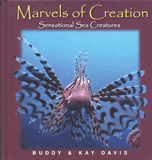A Whale of a Design
Where do scientists find ideas to improve existing technology? Increasingly, the marvels of life—from the microscopic to the massive—inspire engineering breakthroughs. Knowingly or not, scientists are imitating God’s own incredible designs.
His first encounter with the humpback whale fin at a sculpture gallery drove biologist Frank Fish to study the strange design. Puzzled by the fin’s “bumpy” leading edge, he first thought the sculptor had made a mistake. Learning that the sculptor was right, Fish spent years studying the design, which defies traditional theories that would suggest a smooth edge.1
In his research—later confirmed by a team of Harvard scientists—Fish determined that the fin’s bumps, known as tubercles, allow it to easily exceed “what [human-engineered] systems can accomplish.” The bumps help create vortices as water passes across the flipper, generating eight percent more lift and one-third less drag than smooth fins on other whales.
An experimental wind turbine, with a design based on the humpback whale’s “bumpy” fin, promises to generate more power than conventional turbines.
Now Fish’s new venture, WhalePower Corporation, seeks to apply his discovery to turbine and fan technology. WhalePower has teamed up with Envira-North Systems to design a new line of humpback-inspired industrial ceiling fans that are 20 percent more efficient than older models. And the Wind Energy Institute of Canada, in cooperation with WhalePower, is testing a wind turbine on Prince Edward Island.2
Fish speculates that the innovation could even be applied to helicopter blades someday. In the meantime, he’s busy working with the U.S. military on a robotic submarine, based on the unique construction of the manta ray.
The Society for Experimental Biology3 touts Dr. Fish’s research as an example of the grand designer behind the humpback whale’s marvelous fin: evolution over millions of years. Of course, if a humble whale fin can transcend our best scientists’ understanding of air and water flow, perhaps they need to take a step back and acknowledge the obvious testimony to a superior Intellect at work. The fin shows not signs of evolutionary tinkering but the brilliance of our master Designer.
Answers Magazine
April – June 2009
Spring vacations and summer trips require a little advanced planning. It’s not too soon to start thinking about that much-needed family getaway. Vacations help relieve stress, bond families, and create lasting memories. But they can also provide learning opportunities that draw us closer to our Creator. Get tips for ten vacation destinations that will help build your family’s biblical worldview, in a way they’ll never forget!
Browse IssueFootnotes
- “A Whale of a Turbine,” The Guardian, June 24, 2008, http://www.guardian.co.uk/science/2008/jun/24/animalbehaviour.usa.
- Tyler Hamilton, “Whale-Inspired Wind Turbines,” Technology Review, March 6, 2008, http://www.technologyreview.com/energy/20379/?a=f.
- “Whales and Dolphins Influence New Wind Turbine Design,” Society for Experimental Biology press release, July 7, 2008.
Recommended Resources

Answers in Genesis is an apologetics ministry, dedicated to helping Christians defend their faith and proclaim the good news of Jesus Christ.
- Customer Service 800.778.3390
- Available Monday–Friday | 9 AM–5 PM ET
- © 2025 Answers in Genesis





